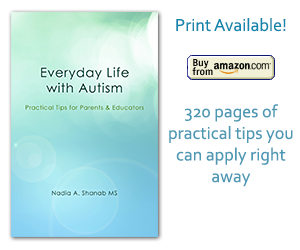Sensory Problems
Nadia Shanab | autism, general advice, parenting, tips26 Jun 2010
What appears to us as a misbehavior, is in fact a reaction of autistic children to their overwhelming environment. Often times they are oversensitive (hypersensitive). On the other hand, they can be indifferent to the input to their senses or under sensitive (hypo sensitive). If they get overstimulated they try to do anything to self-regulate their body in order to retrieve their body and mind balance.
Here are some examples of the different behaviors that we perceive as inappropriate.
- The child plugs or covers her/his ears. If very annoyed she/he may cry or scream (auditory disorder).
- The child is indifferent to noises and doesn’t seem to know the source of voices and doesn’t respond to her/his name being called on (auditory disorder).
- The child pushes away whoever wants to hug or touch her/him (tactile disorder).
- The child is bothered by the tags, seams and texture of the clothes and socks (tactile disorder).
- The child is indifferent to pain and injuries (tactile disorder).
- The child enjoys deep pressure (tactile disorder).
- The child is hypersensitive to movements and afraid of heights (vestibular disorder).
- The child doesn’t get dizzy after spinning for a long time (vestibular disorder).
- The child is rocking or shaking her/his body (vestibular disorder).
- The child covers her/his eyes or squints (visual disorder).
- The child cannot make a puzzle, or sort by color or shapes (visual disorder).
- The child is bothered by odors and aromas and keeps smelling everything before eating or drinking (olfactory disorder).
- The child is very picky with food (oral disorder).
- The child is capable of eating rotten food or inedible things like leaves (taste disorder).
These are called sensory-integration disorders (SID) due to the different wiring in the brain. The perception of the sensory input from the environment is misinterpreted. According to Jean Ayres it is a “sort of traffic jam” in the brain. In each child, senses are processing (through the brain) the input from the environment differently. This explains their uniqueness.
I hope that parents and educators look at these behaviors now with a different perspective. The autistic child is simply trying to communicate and tell something that he cannot describe.
How can we help?
Stay tuned for my upcoming article about tips to help both, teachers and parents, alleviate childrens’ sensory discomfort.
More Tips
Tags: autism, communication, parenting, problems, senses, sensory, tips, visual aids






This is such a great resource that you are providing and you give it away for free. I enjoy seeing websites that understand the value of providing a prime resource for free. I truly loved reading your post. Thanks!
Your are most welcome
My brother recommended I may like this website. He was once entirely right. This post truly made my day. You can not consider simply how much time I had spent for this information! Thank you!
You are most welcome. Thank you both for reading.